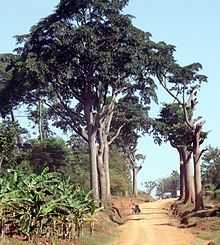Milicia excelsa
| Milicia excelsa | |
|---|---|
 | |
| Conservation status | |
| Scientific classification | |
| Kingdom: | Plantae |
| (unranked): | Angiosperms |
| (unranked): | Eudicots |
| (unranked): | Rosids |
| Order: | Rosales |
| Family: | Moraceae |
| Genus: | Milicia |
| Species: | M. excelsa |
| Binomial name | |
| Milicia excelsa (Welw.) C.C. Berg | |
| Synonyms[1] | |
| |
Milicia excelsa (commonly known as African teak, Mvule or Iroko) is a tree species from tropical Africa. It is threatened by habitat loss.[2] It is one of two tree species yielding timber known as iroko, the other being Milicia regia. The seed is mainly dispersed by bats.
Description
African teak is a large deciduous tree growing to 50 metres (160 ft) high. The trunk is bare lower down with the first branch usually at least 20 metres (66 ft) above the ground. It often has several short buttress roots at the base. The bark is pale or dark grey, thick but little fissured, and if it gets damaged it oozes milky latex. There are a few thick branches in the crown all fairly horizontal giving an umbrella shape. The smaller branches hang down in female trees and curve up in male trees. The leaves are 5 to 10 centimetres (2.0 to 3.9 in) long, ovate or elliptical with a finely toothed edge, green and smooth above and slightly downy beneath. Older leaves turn yellow, and all the leaves have a prominent rectangular mesh of veins visible on the underside. The trees are dioecious. Male trees have white catkins that extend to 15 to 20 centimetres (5.9 to 7.9 in) and dangle from twigs at the axils of the leaves. Female trees have flower spikes measuring 5 to 6 centimetres (2.0 to 2.4 in) long by 2 cm (0.8 in) wide, green with prominent styles. The fruit are long, wrinkled and fleshy with the small seeds embedded in the pulp.[1]
Distribution and habitat
African teak is distributed across tropical central Africa. Its range extends from Guinea-Bissau in the west to Mozambique in the east. It is found in Angola, Benin, Burundi, Cameroon, Central African Republic, the Republic of the Congo, the Democratic Republic of the Congo, Equatorial Guinea, Ethiopia, Gabon, Ghana, Ivory Coast, Kenya, Malawi, Mozambique, Nigeria, Rwanda, São Tomé and Príncipe, Sierra Leone, Sudan, Tanzania, Togo, Uganda and Zimbabwe. Its natural habitat is in wet savannah, rainforest, riverine and low-altitude evergreen forests. It can tolerate an annual rainfall of less than 70 centimetres (28 in) or six months of drought as long as there is a stream or a ground water source nearby.[1]
Ecology
Flowering takes place at different times across the range but often occurs in January and February soon after the time when most of the leaves fall or shortly before the new leaves appear. The fruits take about a month to ripen and are eaten by squirrels, bats, and birds, which disperse the seeds in their droppings.[1]
A study in Ghana found that this tree relies heavily on the straw-coloured fruit bat (Eidolon helvum) for seed dispersal, over 98% of the seed falling to the ground having passed through its gut.[3] This seed also germinated better than uneaten seed and resisted predation longer.[3]
Uses
African teak has strong dark brown hardwood resistant to termites and is used for construction, furniture, joinery, panelling, floors and boats. The tree can be used in the control of erosion. It makes a good shade tree and is useful as a roadside tree in urban areas. It grows rapidly, can be coppiced and is ready for cutting after about fifty years. The tree is nitrogen fixing and the leaves are used for mulching. [4]
The tree is also used in herbal medicine. The powdered bark is used for coughs, heart problems and lassitude. The latex is used as an anti-tumour agent and to clear stomach and throat obstructions. The leaves and the ashes also have medicinal uses.[4]
Mythology
In West Africa, African teak is considered to be a sacred tree. It is often protected when the surrounding bush is cleared, ritual sacrifices take place underneath it and gifts are given to it. Fertility and birth are associated with it and its timber is used to make ceremonial drums and coffins.[5]
Status
African teak is common over much of its wide range. When forests are felled, isolated trees are often left standing and the tree regenerates easily. Fresh seed germinates readily but it loses viability in storage. Some populations, especially plantations, are attacked by a gall mite.[2]
References
- ↑ 1.0 1.1 1.2 1.3 "AgroForestry Tree Database". Retrieved 2012-07-29.
- ↑ 2.0 2.1 "IUCN Red List of Threatened Species". World Conservation Monitoring Centre. 2006. Retrieved 2007-08-22.
- ↑ 3.0 3.1 Taylor, Daniel; Kankam, Bright; Wagner, Michael The role of the fruit bat, Eidolon helvum, in seed dispersal, survival, and germination in Milicia excelsa, a threatened West African hardwood. Northern Arizona University School of Forestry.
- ↑ 4.0 4.1 "Milicia excelsa". Indigenous multipurpose trees of Tanzania: uses and economic benefits. Food and Agriculture Organisation: Forestry Department. Retrieved 2012-07-29.
- ↑ "3.3 The symbolic and sacred significance of particular forest resources". The cultural and symbolic importance of forest resources. Food and Agriculture Organisation: Forestry Department. Retrieved 2012-07-29.
External links
![]() Media related to Milicia excelsa at Wikimedia Commons
Media related to Milicia excelsa at Wikimedia Commons
